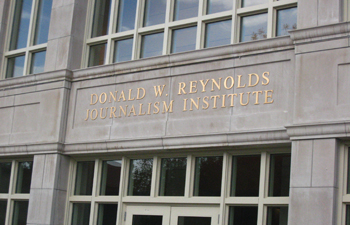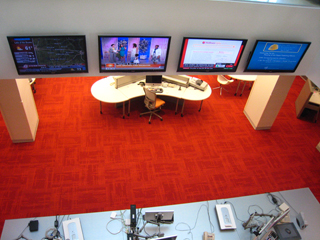
COLUMBIA, MO — I am at the new Reynolds Journalism Institute building on the campus of the University of Missouri, my alma mater. It’s interesting to be in a new building looking out on a campus that is so familiar and so different now. The mission of the RJI is to “develop and test ways to improve journalism through new technology and improved processes. In partnership with media organizations and nonprofits, RJI delivers technological and strategic innovations in journalism and advertising.” They see themselves as an incubator of sort within the journalism school, to try to inject new media and technology into the oldest journalism school.
Yesterday, I judged the student iPhone app competition, with student teams combining journalism and computer science majors working together to make real commercial apps — with the winner going to Apple Inc. in Cupertino, Calif., to present it to the company’s iPhone team. The winner will be announced later today and put on a really impressive presentation, both technically and marketing-wise.
Today’s symposium is titled Building New Tools, New Business Models and New Jobs. If you follow this link, you can participate in the conference virtually via Adobe Connect.
The year-long RJI fellows are presenting what they’ve been working on for the past year, and the incoming fellows will be announced later today.

First up Margaret Duffy (on faculty and RJI fellow) presented the Youth and Young Adult Media site.
Duffy: We set it up so journalists can use it as a resource to reach young people. Mojo-ad.com network set up 4 years ago and sells to Best Buy and other groups. It’s been very successful and this year we had Purina’s as a client. They want this to be the site to go to to get research related to young people. It’s in pre-pre beta right now. There will be an area for research and reports, discussion boards and research. We want information to be as current as possible.
Roger Fidler, RJI fellow: Will e-readers save newspapers? My honest answer to that is “I don’t know” but it does look promising. You’ve heard about the Amazon Kindle, which is the first device that people are really buying and I see people using it when I travel. Most newspapers in the U.S. are providing a Kindle version. But this device, like the Sony Reader, is built for books and not for newspapers, it’s not the best experience for reading newspapers. What’s exciting is the magazine display that you can see in Europe, but even more exciting is the Plastic Logic flexible display.
Tomorrow morning, Amazon and the New York Times will make an announcement about a new product, which everyone believes will be a magazine-sized e-reader. Plus Amazon wants to get into the textbook market with a larger product. We’ll see how that device plays out and what price it will be.
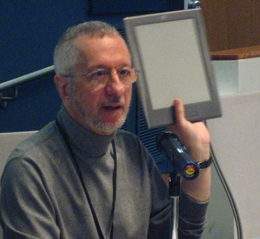
These are still expensive devices, they’re not down to $100 yet. Should newspapers subsidize them to sell subscriptions? Should they give people a free e-reader in exchange for a two-year subscription. The business models are still a work in progress. Tomorrow we’ll talk about whether newspapers should create a consortium to work together on e-readers. One of the problems is that they don’t have video or color screens either.
NY Times guy: We are not really interested in doing advertising on Kindle and e-readers yet, but it’s more about bringing in revenues for our content.
Bill Densmore, RJI fellow: What’s the “Information Valet Project”? It’s about helping people find access to info anywhere, creating conversation, community and networks. We need to think about news social networks. We coined the term “InfoValey” which is the trusted advisor/broker who would attend to your info needs. I have worked for the AP and in trade publishing and by 1994 I saw a train wreck coming for the news industry.
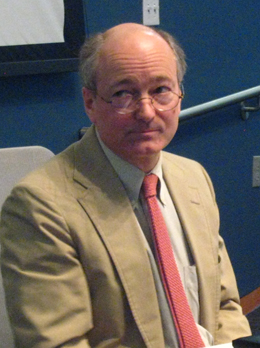
Our first process here at RJI was to process ideas, so we put together a meeting with 50 people. The question was: How do we sustain the value and purposes of journalism? Mass markets are splintering. There’s an end to the mass market, so we need to build a custom news feed with an InfoValet. We did applications research, took that data to Martin Langeveld and to Jeff Vander Clute and tried to figure out how to make this into a product.
Research question: How will consumers value their privacy in trade for digital goods? We surveyed freshman students, journalists’ views. We created “spheres of belonging,” places where they are comfortable sharing information, and the InfoValet will have to respect those boundaries.
Mike Fancher, RJI fellow (former Seattle Times editor): My project was to find out if the public service journalism that Missouri journalism school founder Walter Williams spelled out would still be viable today. He co-authored what was arguably the first journalism textbook in 1911. He wrote: “Printing is necessary to the publishing of the journal…but expression not medium constitutes journalism.” In 1914 he wrote the journalist’s creed. It’s kind of like poetry, a little old-fashioned. It’s interesting that it’s about the “who” and the “why” — the character of the journalist.
That takes on new meaning today when anyone can be a publisher. It’s now about the character of people. Any profession in crisis should not just consider standards, but the identity — personal integrity and values. With Williams, he is interested in the highest personal standards. My project will propose that those standards are necessary but should be improved. Williams talked about the journalism that best deserves to succeed, and I think the new journalism will embrace those values but also embrace new technology as a new way of networking. Journalism will be a center of a community, and the public trust won’t be an abstract notion but an abiding way to connect on a human level.
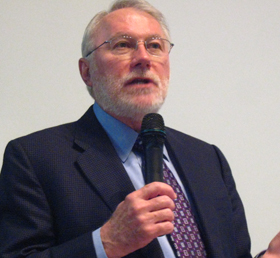
It won’t be seen as hostile as it is today. It will recognize that journalism is not just on behalf of people but with them. Today, working journalists find it very hard to work in this direction. We don’t even have the vocabulary established. We will need to let go of the sense that we have control. We will see the public as true partners.
I think we’ll see much more collaboration in the future, and it will be much harder for journalists to fight for independence and fight litigation. If journalism is just a business and doesn’t stand for anything, then all the journalists’ protections could be in jeopardy. I think there will be vibrant newsrooms but in a very different form and a different business model.
*****
There’s a break in the action, and the next set of RJI fellows will present soon. The discussions have been really productive so far. I was lacking Net access at the beginning so didn’t get to capture some of the more in-depth discussions. But there was a sense that technology is bringing a lot of new possibilities for journalism rather than just spelling doom and downfall. Some of the veteran journalists in the room sounded a bit worried about the loss of so many jobs in traditional journalism, and obviously fearful about what new models will replace the old ones.
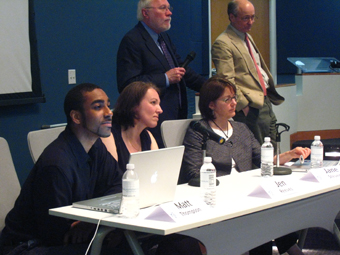
Next up is Matt Thompson, whose project was “Wikipedia’ing the News” and putting news into context. Martin Langeveld recently wrote up a nice piece on Nieman Journalism Lab on Thompson’s project after a meetup in DC.
Pam Johnson, RJI director: Announcing the new set of RJI fellows, including Michele McLellan. Michael Skoler, who was on sabbatical last year, and was formerly executive director at the Center for Innovation in Journalism at American Public Media and Minnesota Public Media. He will research case studies of business models that are working. Sean Patrick Reily is director of editorial business and planning at the LA Times. Stephanie Padgett is a media planner at Empower media and marketing company. She couldn’t make it today. We have two Missouri fellows: Jacqui Banaszynski, the Knight chair in editing at Missouri, and will look at partnering between the public and the press; and Clyde Bentley, who is trying to create the mobile template for news organizations.
Matt Thompson, RJI fellow: [from video presentation]: We have an endless display of information to snack on. We want to be not just diverted but informed. Sites can tell us what happened in the past few hours or days but not more depth on context or the larger story and how those stories fit together. There’s too much information and consumers are overwhelmed. I came to RJI to map out a new territory that news organizations could conquer: context.
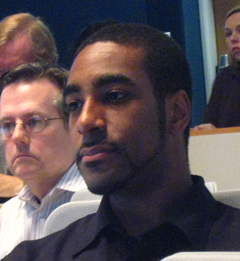
I created The Money Meltdown site to aggregate stories on one subject and got 50,000+ page views in two days of work. We set up Columbia Tomorrow, about growth and development in Columbia.
Jane Stevens, RJI fellow: I came here with some understanding of the characteristics of this new environment, above all being participatory, with social networking pushing us into the future. It’s solution oriented and personal. You can have video, audio, slides, text and graphics. In my quest to build out a niche news network, I first looked for a new content management system, and decided to use Ellington because they were merging databases and other features I wanted. We had 3 case studies, including West Seattle Blog, QuincyNews.com and CapitolHillSeattle. We started the RJI Collaboratory, with more than 300 members, and we put our projects on here, along with a wiki for it.
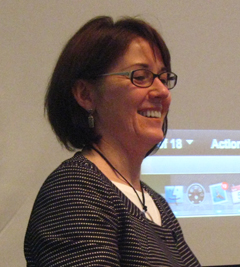
We build the Health Commons website, covering health care in Boone County, combining a social network, news, aggregator, and includes resources to make it a go-to place for health in the community. We will be tweaking this because we will listen to what the community wants. We have six sections and looked to see what was affecting the community the most. The site is still in development.
Jennifer Reeves, RJI fellow: My main goal and focus is community. It started with our Centennial celebration for the j-school, to talk to journalists that were here and learn lessons that they’ve learned in their career. We had 522 videos posted to YouTube, creating a huge database of perspectives to share with the journalism community. I also worked on Smart Decision ’08, bringing in all the election content on one site, based on the candidate and not the newsroom. I wanted to build political community. What I didn’t do was identify the community first.
The biggest success was when we did a webcast with exclusive content for all our websites. We had a watch party going on and we interacted with the community. [Shows 38 second video of election night coverage.] We had a crew following Twitter discussions, blogs, and it was great to see that community come together. I did a project in Drupal to bring in different RSS feeds from different newsrooms. I focused on the technology and not the community, tried WordPress and did a MoneyCommons.com site about the economy. But I stopped it because we were talking about news content first before thinking about community.
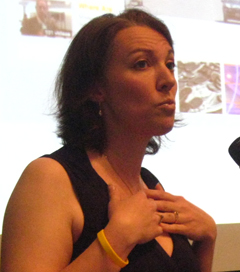
I realize that what’s most important is to find where communities are talking and reach out to people. I’ve been teaching students about social networking and participating in conversations, and dug into the tools I was using as a person and expanded that into my work. I’ve done a lot of work on Twitter and am bringing those skills over to KOMU. I have taken the schools to help students build new identities and e-portfolios. The next step is how faculty can bridge community, and foster communications and become better journalists.
Jane Stevens: I will be moving on to work at the World Company in Lawrence, Kansas, to work in online. The Health Commons will continue to live on beyond my time here. I think it’s important to support entrepreneurial journalists within organizations as well as those who are outside organizations.
Amy Senk was a graduate here at Missouri and she wanted to launch a niche news site, and did it on her own about her own community. And people at the Collaboratory help her all along the way.
iPhone App Competition
After a lunch discussion between the first-year fellows and the new incoming fellows, the Symposium continued, this time with the four finalists in the iPhone app development competition. The contest started at the beginning of the school year, including a “speed dating” meetup between computer and journalism students to find out common interests and create teams to compete. They were whittled down to a “Final Four” who presented to judges (including me) yesterday. There was also an online voting element.
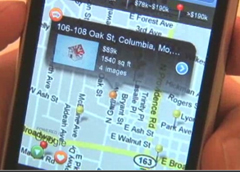
The first finalist is called The ADverse Network. They wanted to do more than just create an iPhone app. They wanted to create a geo-located advertising service, so that you would get local ads based on your location. Ads are inserted into the two apps we developed, iCoMoNews and Vox. For the advertisers, there are tools like a live map that shows where people are accessing the network, and even more granular “heat maps” to show where people are viewing and clicking on ads. They say they got a clickthrough rate on ads of 3.8% which is pretty good.
Next up is NewsFlash. They had a lot of ideas for apps but ran into technical and legal issues. Then they decided to create a custom news reader that could bring up local news and topical news for free without ads. When they uploaded the application to the App Store, they hit a problem with the user interface, and had to resubmit the app. They released it to the store on April 26, and were surprised at nationwide and global usage. We had downloads in every continent but Antarctica but considered using our budget to go down there and log on. [laughter]
They got positive reviews on the iTunes site, and were featured on an iPhone app blog. In the “free news” category, they’ve reached the #15 spot. So how can they improve it? They want to work on better international location results, remove web server dependency and make updates based on user feedback.
Next is NearBuy, a real estate location service. The app uses your location to serve up either homes for sale in the area or apartments for rent. They bring in listings from Google Base, Craigslist and Oodle. You can then view info on listings on a map, including photos, property details, contact information. Plus, you can use Twitter to query people for opinions on particular places, and then rate the place. Extras include a rent calculator and a Flickr add-on that lets you see photos geo-coded nearby.
Mike McKean at RJI says they want to take the contest to the next level, and make it more of a routine in more classes. In fact, there will be a class next fall where companies have students develop iPhone apps, and the student breakdown will be 30 computer science students with 10 journalism students.
Now a discussion took place about intellectual property and ownership issues. The University of Missouri didn’t clarify until midway through the contest what would happen with apps, who would get what revenues and how ownership and royalties would be split. When the students learned that the terms were not that great, some wanted to pull out of the contest. The RJI folks are pushing the University to give the students better terms of ownership, perhaps 75% for students and 25% for the University, in order to keep enough incentive to create something with a business return. There will be a discussion on this topic later today.
And the winner is… NearBuy. The winner for the People’s Choice award, with voting online, goes to NewsFlash.
Here’s a Flip cam video I shot of the winning presentation from NearBuy:
Challenges of Intellectual Property Ownership for Students
Ken Dean is deputy provost: I want to confess that I’m a capitalist and believe in entrepreneurship, but I’m also an employee of the University of Missouri, a public instittution. So there’s a balancing act to figure out where the priorities should be. We’d like to encourage entrepreneurship, but you as faculty, students and employees, but we don’t want to put our resources at risk. That’s our framework for operating in this environment.
Harriet Francis, office of industry relation management: We do have a lot of rules, unfortunately, which sometimes causes us aggravation. We’re just now beginning to understand intellectual property in humanities and journalism, not only with the iPhone and Adobe Air competitions but also with what the RJI fellows are doing. It falls under rules and regulations at the University. Inventions made by students need to be disclosed. A series of questions happens to see if University has an interest in the IP, whether it’s patentable or copyrightable. If it’s monetized, what the division of the money should be. We think it’s a generous division of royalty money.
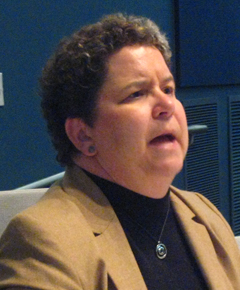
Kelly Mescher, in general counsel office at school: I started with the agreement with Apple just to begin the competition. Apple is a big guy and wanted it their way, and when said it didn’t quite fit. Apple wants to benefit as well, and would like to get something from us without doing much. But we didn’t want to give those away. I wanted to make sure the University made the kind of agreement that gave us something back.
Francis explains that the usual split with IP rights is: 33% of royalties go to inventor, and 67% to the school, though that can vary.
iPhone App Competition as Model for Economic Development
University President Gary Forsee is leading a discussion with entrepreneurs and business folks about how the iPhone app competition can be used as a model for more types of economic and business development. He’s showing a chart of the intellectual property life cycle, and wants to figure out a way to tap the full potential at the University. “How do we support that?” he asks, to take the next step from planning to reality.
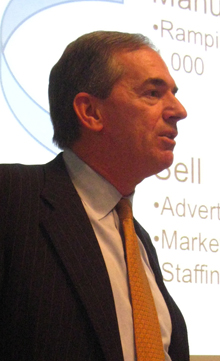
Dan Mehan, state lobbyist: The state of higher education is in serious trouble. By 12th grade we are in the lower echelon when it comes to literacy skills compared to other countries in the world. The Chinese are much better adept at taking on a more rigorous education for the children of tomorrow when it comes to higher education. For the entire US, 35% of students will have to take remedial math and reading. The University system should take advantage of the talent pools that are there, like Jim Spencer at Newsy.com.
Audience member: We need to focus on the successes of researchers who have started businesses, and that’s one thing that’s lacking.
Gary Forsee: We do need to get people to see all the successes we have on campus, to see the energy with students and faculty. Ben Kruse, from AT&T, what did you think about the competition?
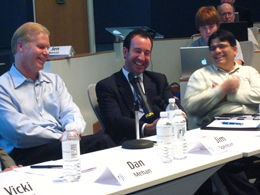
Ben Kruse, AT&T: It was impressive to see the collaboration, led by RJI, the j-school and the computer science school. There were very little guidelines about what this was supposed to be about. We’ve had more rules in other contests we had, but in this case we gave students a lot more leeway and creativity to create what they wanted. It’s exciting to see what applications came back from students, and it went from 15 ideas down to 5, all of which have tremendous potential in the marketplace. Plus, some are already released in the marketplace.
Jim Spencer, Newsy.com: When we wanted to make our deal with the University, we didn’t have to worry about IP, because we didn’t have intellectuals or property! [laughter] So many people in this room helped get us where we are. It takes a lot of people and energy to move our company forward. The encouraging thing is that the students in this room have the opportunity to transform our business like never before. When I graduated pre-Internet, we went to work at major corporations, but now that’s changing. We put Newsy.com across the street so students could see a different way to do things, to do startups and be entrepreneurial.
Mark Glaser is executive editor of MediaShift and Idea Lab. He also writes the bi-weekly OPA Intelligence Report email newsletter for the Online Publishers Association. He lives in San Francisco with his son Julian. You can follow him on Twitter @mediatwit.
